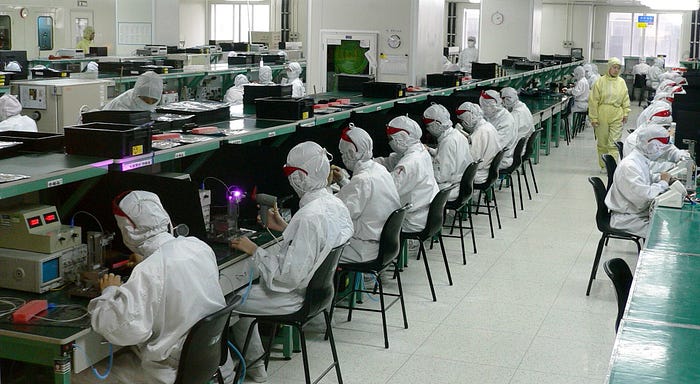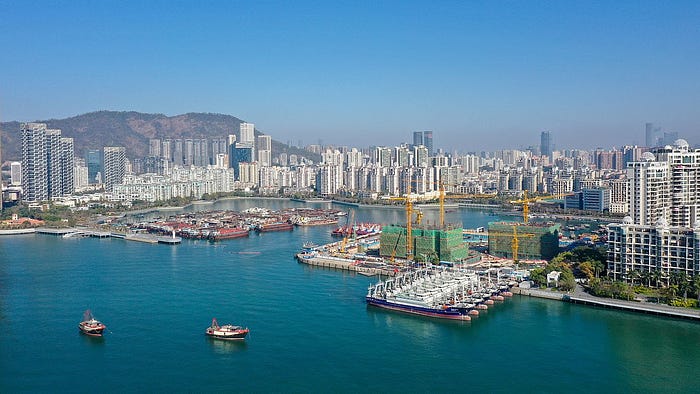When I was growing up, the Chinese economic miracle was in full swing. Its economy was growing explosively, but could it overtake Japan before the middle-income trap or a revolution put an end to that growth?
Back then, people still bothered complaining about things being outsourced to China, rather than just accepting it as a fact of life. Chief amongst those complaints was the appalling work conditions experienced by the poor Chinese.
Working 23 hours per day for almost no money was a great way to make skyscrapers and train stations and Abercrombie T-shirts quickly, but people shook their heads at the atrocities suffered by workers over there. So bad was the life of a Chinese factory worker, everyone knew, that nets had to be installed along the sides of factories to stop workers from killing themselves!
Those suicide nets did exist, and they dominated our perceptions of China back in the day. Anytime China came up in conversation (from school maths class to construction site lunch rooms to barbers to the dinner table), someone would inevitably bring up the suicide nets.
Even today, I occasionally hear people bring up the suicide nets today. Today, the biggest Chinese cities rival Western standards of living, and factory workers earn about the same as those in Greece — but the enduring power of this image keeps some people imagining that China is little more than the world's sweatshop.
The real story, of course, is more complicated.
The media frenzy over the Chinese suicide nets began in 2010, when over a dozen deaths occurred in a factory in Shenzhen, a megacity just across the border from Hong Kong. The factory was operated by Foxconn, a vast Taiwanese electronics contractor heavily associated with the manufacture of Apple products — iPhones, iPads and so on.
The company was criticized by Chinese academics, by student protestors in Hong Kong, and by labour representatives for abusive treatment of employees. Accusations involved managers' cruelty towards subordinates, late paychecks, illegal overtime, and much else. This was a sweatshop, plain and simple — and nothing could demonstrate that better than the reality that employees were throwing themselves off the roof of the factory in despair.
As the suicide count racked up, and Foxconn's "no comment" policy failed to quench the criticism, the story spread from China to international mainstream media. It caused a publicity crisis for Foxconn clients, as Apple desperately tried to deny accusations of using slave labour to assemble their shiny, overpriced gadgets. Apple, in turn, pressured Foxconn to do something about the suicide problem.
Unfortunately for Apple, Foxconn is in the assembly line business, not the PR management business. Their initial reaction was to force employees to sign anti-suicide pledges. Unsurprisingly, that backfired spectacularly, and the pledges were replaced with measures including a pay rise (26%), prayer sessions led by Buddhist monks, and opening the factory up to 200 journalists — which all sounds fairly reasonable.
But alongside these measures, Foxconn also installed suicide nets, and these nets achieved global infamy. China: the land so dystopian that you aren't even allowed to kill yourself.
At the risk of sounding like a communist shill, I'm going to try adding as much nuance as I can without dismissing the human tragedy of this affair and the admittedly serious flaws of Foxconn's operating practices. To begin with, here is what I think is the most important point: the Foxconn factory is big — really, really big.
Actually, calling it "a factory" strains the word's definition. Foxconn's Shenzhen operations are based in a technology park called Foxconn City which houses 15 manufacturing plants and a workforce of 300,000 mostly living on-site. By comparison, the largest factory in the US (the Boeing Everett Production Facility) has a workforce of 30,000.

A dozen suicides at a typical US or German factory would be statistically startling — but when those suicides are spread across a workforce similar in size to Pittsburgh or Florence, they begin to seem a little less shocking. Foxconn CEO Terry Gou was mocked for his insistence that it was not scientifically possible to prevent every suicide, but he was right. The suicide rate at the Foxconn site was lower than in China generally — and much lower than in the US.
That will be scant comfort to those who lost family at Foxconn (or the poor girl whose attempt failed and was left paralysed); but it should force us to question any sweeping generalisations we make about China on the back of this story. If a Swede committed suicide while working at a Volvo plant, or a Californian shot a co-worker at a Tesla factory, I suspect few of us would take it as evidence of slave labour in Sweden or the US.
To some extent, Foxconn was singled out for being a large company with household-name clients (and would have have attracted attention for suicides happening on-site, which is not surprising since workers were living there). Some workers and researchers noted that conditions were actually better at Foxconn City than at many other factories in China; basic pay was only about $130/month, but that was all disposable income since food and lodging were free. At the factory, they had free access to the site's leisure facilities, including swimming pools and cinemas.

Workers, many of them migrants from underdeveloped rural China, could have made the money stretch quite far back in their hometowns since China is much cheaper than the US or Western Europe. These were not slaves; they were people choosing a year or two (annual turnover was 30–40%) of tough graft in the big city for the chance to save something towards a house or a business, rather than working on a local farm for even less.
That said, there were Foxconn-specific problems. For one, the mostly mainland Chinese employees resented that they were at the bottom of the Taiwanese company's corporate hierarchy. There was a culture of bullying and contempt towards mainlanders by the disproportionately Taiwanese managerial and supervisory class, and the mainlanders had a much more difficult time being promoted or even having their mistakes taken seriously.
Another factor that was regularly mentioned in response to the suicides was the inconsistent staffing rota, which made it difficult for new workers to make friends becauseof the lack of a predictable schedule. With vast numbers of young people living hundreds of miles from home, often for the first time and without friends, the emotional distress must have been intense.
I'm not writing this to defend Foxconn; I don't think they were angels. If any good was to come from this tragedy, it's that it put some pressure on the company to do better.
I also don't think the suicides reveal China to be some dystopian Communist dictatorship. Perhaps it is, but what this specific case shows us is that foreign companies from rich countries often mistreat workers in less developed countries (something that would also be true of an American-run hotel in Jamaica, or a Canadian mine in Brazil).
Instead, the Foxconn suicide scandal to me is a vivid demonstration of the challenges faced by countries on a rapid path to development. Like the US, China was and is a country where the economic dynamism is mostly happening in the big coastal cities, and that leads to lots of sacrifice — people forced to travel halfway across the country for better work, time spent away from loved ones, companies obsessed only with the margins rather than humanity or community.
But this all has to be evaluated within the reality of China's growth. If Foxconn (and companies like it) weren't there, people would still be suffering; they would just be doing it thousands of miles in the interior, well-away from the eyes of journalists. And the bright side is that things are getting better — workers in Chinese factories now earn $8 / hour on average, higher than most of Latin America and comparable to countries like Portugal and Greece.
All things considered, the suicide net story was seized upon by well-intentioned media and protestors that lacked a sense of scale, and a public that was looking for reasons to dismiss China. It deserved to be covered, but popular obsession with this vivid (and statistically meaningless) situation led to it receiving more than its fair share of China coverage. It should serve, if nothing else, to be thoughtful if our analysis of a country that has continually defied our predictions.
